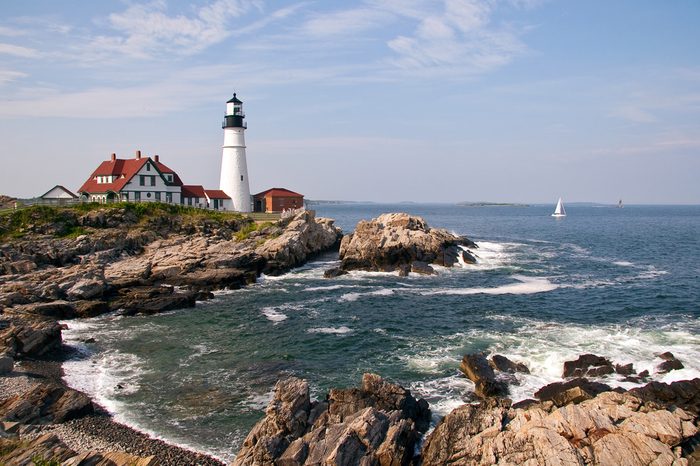
Wisconsin
Wisconsin ranks 15th worst for cancer diagnoses with 467 per 100,000. Wisconsin’s cancer death rate is just shy of 163 per 100,000, placing it smack in the middle of the nation’s rankings at 13.
The Centers for Disease Control and Prevention and the National Cancer Institute published a comprehensive report on national cancer statistics titled, Leading Cancer Cases and Deaths, Male and Female, 2012-2016. The report reveals, among other things, each state’s cancer rate per 100,000 people from 2012-2016. For comparison, the overall U.S. rate is 448 new cases per 100,000 people. An important thing to know about cancer rates: The better a state is at screening for cancer, the more disease it will find; in other words, don’t despair if your state happens to be in the top 20 list. Take a close look at your state’s death rate from cancer (the average in the U.S. is 161 per 100,000): Your state could have a great track record of treating cancer and helping people survive.Here’s some more good news about the fight against cancer.

With slightly more than 521 new cases per 100,000 people, Kentucky has the highest cancer rate in the country. It also has the highest cancer death rate in the country—198 per 100,000 people. The three types of cancer with the highest prevalence (meaning the most people living with a cancer diagnosed either recently or in the past) were breast, prostate, and lung—as is true for most of the states on this list. However, the death rate due to lung cancer was a striking rate of 66 per 100,000, which is higher than the average death rate from lung cancer in the US which is 42 per 100,000. Here’s the lifestyle changes cancer doctors make to avoid cancer.

Although Delaware’s cancer rate—498.4 per 100,000—is second in the country and well above the national average, the state’s cancer death rate is 169.6 per 100,000. The top three causes of cancer death in Delaware are female breast, prostate, and lung. The best way to lower risk of lung cancer is to stop smoking. Here are 23 ways to quit smoking for good.

With a rate of 487 per 100,000, Pennsylvania comes in at the third highest. While breast, prostate, and lung cancers are the most prevalent, thyroid cancer is more common in Pennsylvania than in other states. Penn State researchers report that the state’s incidence of thyroid cancer may be higher than it is in the rest of the United States, possibly due to the Three Mile Island incident back in 1979. The cause of thyroid cancer is often unknown, but exposure to low-dose radiation in childhood, as well as obesity, are known risk factors. The thyroid cancer rates did not go up right after the nuclear plant accident in the late 1970s, so other risk factors like obesity or better detection in recent years could be to blame for the higher rates. And the good news is that thyroid cancer is highly curable. Pennsylvania’s cancer death rate is 169 per 100,000.
These are six symptoms of thyroid cancer you shouldn’t ignore.

New Hampshire ranks fourth in the nation for cancer diagnoses at 483.5 per 100,000. Lung, breast and prostate are the most common cancers diagnosed in New Hampshire. The state’s cancer death rate is 162per 100,000, slightly less than the national average. Here are 10 prostate cancer myths that might surprise you.
Tied with New York, New Jersey has the fifth highest cancer rate in the country—about 483.4 per 100,000—and a cancer death rate of 153.5, Jersey’s high diagnosis rate may have something to do with the levels of radon: As many as one in six New Jersey homes may register some level of contamination, according to this map from the New Jersey Department of Environmental Protection. But again, there are a lot of risk factors for cancer that can complicate the picture, and better screening can also raise the rates. Here’s what you need to know about radon testing.

With a rate of about 482 per 100,000, New York is sixth in the nation for cancer diagnoses. New York is below the national average death rate, coming in at 151per 100,000. In 2016, pancreatic cancer became one of the top three causes of cancer death in New York. This is why pancreatic cancer is so hard to treat.

Louisiana is the seventh highest state for cancer diagnoses, with 481 per 100,000. The state’s death rate of roughly 183 per 100,000, however, is higher than the nation’s average, placing it tenth in the nation for cancer deaths. Here are nine surprising risk factors for cancer.

At 477.5 per 100,000, Rhode Island ranks eighth worst in the nation for new cases of cancer. The state also comes in below the national death rate—165 per 100,000. Lung, female breast and prostate are the leading cancer killers in Rhode Island.

At 476 per 100,000, West Virginia comes in ninth worst in the nation for diagnoses. It also ranks third in the nation for highest cancer death rates—at slightly less than 190 per 100,000. Lung, breast and colon cancer are the top causes of cancer death in West Virginia. Here are 12 cancer-fighting foods to eat every day whether you live in West Virginia or another state.

At 475.9 per 100,000, Maine’s rate of cancer diagnoses are just slightly behind those in West Virginia, making it the 10th highest in the US . With a death rate of 174 per 100,000, it ranks 12th worst in cancer deaths. Female breast, prostate and lung cancer are among the most commonly diagnosed cancers in Maine. Here are 6 proven habits to prevent breast cancer no matter what state you live in.

Iowa’s rate of cancer diagnoses is 475.2 per 100,000, making it 11th in the nation. With 165.6 deaths per 100,000, which is higher than the overall death rate from cancer in the US. Here are 30 simple ways to prevent cancer.

With an incidence rate of 472,4 per 100,000, Connecticut ranks 12th in the nation. This may be due to Connecticut’s higher-than-average rate of breast cancer diagnoses—140 new cases per 100,000 people—placing it second in the nation (behind New Hampshire). However, Connecticut’s cancer death rate of 127 per 100,000 is well below the national average and places it among the top ten states for survival—seventh best overall. Here are the ten commandments for emotionally coping with a breast cancer diagnosis.

Number 13 in the nation for cancer diagnoses, Mississippi has a rate of 468.6 per 100,000. Unfortunately, the state’s cancer death rate of 194 per 100,000 puts Mississippi second worst in the nation, ahead of only Kentucky. Mississippi also has the fourth highest rate of lung cancer diagnoses in the US. Here are seven signs of lung cancer you may be ignoring.

Arkansas ranks 14th highest in the country for cancer diagnoses, with a rate of 464 per 100,000. With a cancer death rate of slightly more than 85 per 100,000, Arkansas has the fourth highest rate of cancer deaths in the US. Arkansas is also has the fifth highest rate of colon cancer deaths. Here’s a breakdown of 9 colorectal cancer risk factors you can control—and 7 you can’t.

Georgia
At 466.4 per 100,000, Georgia’s cancer diagnosis rate places it as the 16th worst in the nation, and its cancer death rate of 165.6 per 100,000, places it above the nation’s average. Check out the 15 things that cancer doctors do to prevent cancer.

This state’s diagnosis rate of 466.2 per 100,000 puts it 17th worst in the nation. At 168.5 per 100,000, Illinois ranks slightly higher than the US average in terms of cancer deaths. As in many other states, lung, breast and prostate cancer top the list of diagnoses and cancer-related deaths. Screening is the best way to catch cancers early when they are in their most treatable stages.

At 18, the tobacco state of North Carolina ranks slightly better than Illinois in cancer diagnoses at 466.1 per 100,000, but its cancer death rate of 167 per 100,000 is below average. The prevalence of lung cancer (almost 69 diagnoses out of 100,000 cases versus the national average of 59) may account for the higher-than-average cancer mortality rate in North Carolina. Quitting smoking is the best thing you can do to lower your risk for lung cancer. Here are seven ways to take back your health after you kick this habit.

Kansas comes in at 19th in the nation with a diagnosis rate of 464.5 per 100,000. This middle-of-the-country state also comes in the middle for cancer death rates (164.2 per 100,000), and its top 10 most common cancer diagnoses all hover around the national average, as well. Here are 21 genius cancer breakthroughs scientists wish you knew.

Minnesota ranks 20th in the nation for cancer diagnoses (464 per 100,000), which places it above the national average. But Minnesota’s cancer death rate is well below average at 153.4 per 100,000, lower than the US average. The state’s lung cancer diagnosis rate is below the national average.